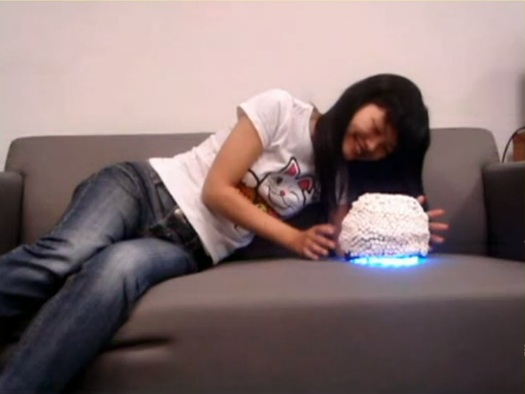I love you, you love me, Robot
2011/09/03 Galarraga Aiestaran, Ana - Elhuyar Zientzia

Although the area is in its beginnings, the Social Robotics Laboratory of the University of Singapore has already built a prototype. It has been presented at various congresses and has included videos on You Tube. The videos have explained the operation of the robot and have made representations to show how it behaves, for example, when the person who loves caresses (approaches him) and when that person talks to another (moves away and pretends).
The truth is that in view of the video, in the movements of the robot these two stereotyped behaviors are easily identified, that is, satisfaction with loving gestures and jealousy. However, according to the researchers, in their research they have sought to keep the relationship in both directions, which is more difficult to see in the video. Surely the appearance of the robot does not help much to it, because it does not seem very dear (it looks like a revolutionized casserole).
In any case, the research is technically very interesting. Social robots already have systems of interaction with the environment and people. A robot-specific behavior module has been designed at the University of Singapore to act properly to achieve a deep bond with a person.
To “decide” how to act, the robot receives two types of auditory and tactile signals from the person. The answers, in addition to these two forms, are given by color, motion and vibration. Moreover, it controls parameters such as closeness, repetition, adhesion, imitation and attraction.
In fact, according to researchers, they are the behavioral factors that most influence loving relationships. Therefore, they have developed and applied to the robot a computer model that contemplates these factors so that it can behave properly when interacting with his lover and his environment.
Hormonal equations
However, the most striking thing is that the robot has been subjected to an artificial hormone system. It seems that this system is key for the robot to have the ability to love and be loved. Among the artificial hormones they have used are dopamine, serotonin, endorphin and oxytocin, all of them closely related to the emotions that live in loving relationships: excitement, joy, well-being, satisfaction, empathy, trust, adherence...
In addition to these four hormones, some have been added related to biological parameters (blood glucose concentration, heart rate, body temperature, hunger...): melatonin, epinephrine, noepinephrine, orexin, greline and neptina. Together with the previous ones, they are all variables of the equations that determine the behavior of the robot.
According to the researchers, the robot behaves affectively and emotionally. In addition, this bond is permanent, is consolidated over time and is bidirectional. So, for example, you will feel less love than your regular lover about a person you just met. Anyone knows, the robot can succeed among those seeking such a relationship.
Published in Annex GAUR8.

Gai honi buruzko eduki gehiago
Elhuyarrek garatutako teknologia





